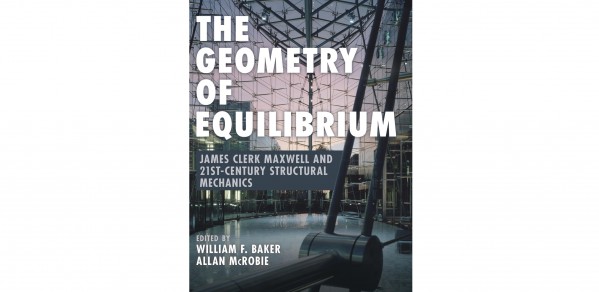
'The Geometry of Equilibrium - James Clerk Maxwell and 21st-Century Structural Mechanics' is the first book to examine James Clerk Maxwell's key discoveries in structural mechanics and their importance in the 21st century.
I have found that exploring Maxwell's contributions to structural mechanics and the geometry of equilibrium has greatly changed my approach to the design of structures. The book essentially translates Maxwell's work from the 19th century to the 21st century, and, in the process, uncovers opportunities in design, science and mathematics that were not possible to explore in Maxwell's time.
Professor William F. Baker Emeritus Honorary Professor of Structural Engineering Design
William F. Baker Emeritus Honorary Professor of Structural Engineering Design along with Allan McRobie, Professor of Structural Engineering are the editors of the recently published book.
James Clerk Maxwell (1831-1879) is one of the giants of scientific thought, and whilst his groundbreaking contributions to electromagnetism and statistical physics are well known, his profound insights into the theory of structures are appreciated less widely. Maxwell's approach was deeply geometrical, and this richly illustrated book reveals his astute perception of the remarkable dualities that exist between the form of a structure and the forces it can carry, with findings that will surprise contemporary readers.
Early chapters introduce the background in which Maxwell was working, followed by contributions by leading researchers describing the latest applications of these ideas. Subsequent chapters introduce the many subtopics that this work embraces. The book ends with Maxwell's original papers on structural mechanics, each annotated to highlight and explain the ideas therein. This is a wonderful resource for mathematicians, scientists, engineers, and designers to enter this rich and under explored aspect of the genius of Maxwell.
In the millennium poll Maxwell was voted the third greatest physicist of all time – behind Newton and Einstein. He is best known for his equations of electromagnetism and thermodynamic relations, but his interests and achievements extended far beyond these fields. His profound insights across many extraordinarily diverse areas have laid the foundations for much of contemporary physical science.
Maxwell had strong links with the Cambridge Philosophical Society during his time at Cambridge. He studied mathematics as an undergraduate – initially at Peterhouse, but moving to Trinity before the end of his first term. He graduated in 1854. He published his early papers in the Proceedings and Transactions of the Royal Society of Edinburgh including one called The equilibrium of elastic solids. He published his paper On the transformation of surfaces by bending in the Mathematical Proceedings of the Cambridge Philosophical Society.
His career took him to Aberdeen, King’s College London and his family estates at Glenlair before returning to Cambridge in 1871 to become the first Cavendish Professor of Experimental Physics. He was President of the Cambridge Philosophical Society 1875-1877. In 1879 he died in Cambridge just steps away from the Department of Engineering at 11 Scroope Terrace at the age of 48.
Professor Bill Baker and Professor Allan McRobie the editors of the book recently made presentations to the Cambridge Philosophical Society about the journey they had uncovering the unknown contributions of Maxwell to the Geometry of Structural Equilibrium. The videos of those presentations can be watched at the links below.
Professor Bill Baker is one of the world’s leading structural engineers. He is best known for the development of the “buttressed core” structural system for the Burj Khalifa, in Dubai, the world’s tallest man-made structure.
His cutting-edge long-span roof structure designs include the unique Broadgate Exchange House in London, which is both a building and a bridge that spans over Liverpool Street Station, and the cable-supported entry pavilion for the General Motors Headquarters in Detroit.
Bill is widely recognised for his collaborations with renowned artists, such as James Carpenter, Janet Echelman, Iñigo Manglano-Ovalle, James Turrell, and Jaume Plensa.
He is Consulting Partner at Skidmore, Owings and Merrill (SOM) in Chicago.
In addition to his professional practice, he teaches at MIT and the University of Cambridge where he is the Emeritus Honorary Professor of Structural Engineering Design.
Bill has developed an undergraduate course at the University of Cambridge on Advanced Structural Design that draws heavily on the material covered in the book. Whilst the course has a strong theoretical basis it puts great focus on how these new understandings provide practical techniques for the design of materially-efficient structures. Each year, Bill travels to Cambridge especially, spending a whole term here delivering this course to the fourth year MEng students.
Professor Allan McRobie is Professor of Structural Engineering at the University of Cambridge. His research interests have included structural design, stability and dynamics, with particular focus on complex dynamic load environments such as wind excitation of bridges and crowd loading, together with extreme value theory for rational risk management associated with “high consequence, low probability” events that can lead to structural failure. Allan has further interests in water and sanitation infrastructure, particularly in megacity slums.
He previously authored 'The Seduction of Curves' (2017) on the mathematics of curved geometry.
Since 2015, Allan and Bill have been working on exploring and extending Maxwell’s theories of structural mechanics, culminating in the co-editing of the book, The Geometry of Equilibrium: James Clerk Maxwell and 21st Century Structural Mechanics, (Cambridge University Press).

